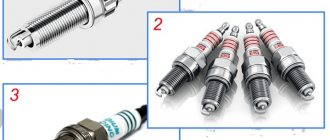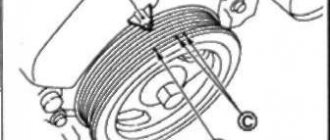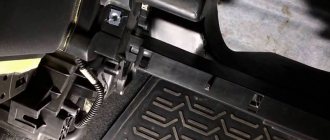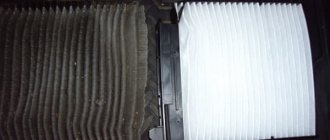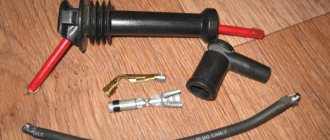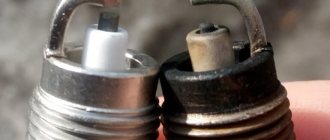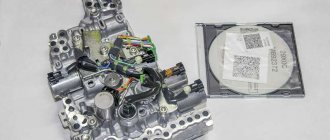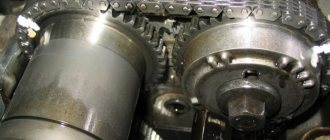Nissan Qashqai, produced in 2 generations and having undergone 2 restylings, has not lost its position in the market since 2008. A compact-looking car with the price and fuel consumption of a sedan, and the roominess and cross-country ability of a crossover, it is loved by many motorists in Russia.
Nissan Qashqai went on sale in 2007. This was the first generation, released in the J10 body, which was restyled in 2009 and was produced until 2012. Gasoline engines were presented in two versions - 1.6 and 2 liters (HR15DE\HR16DE, the same as in the Nissan Tiila C11).
The second generation Nissan Qashqai has been produced since 2013 in the J11 body. A petrol version with a 1.2-liter turbo was added, restyling was carried out in 2022. The Qashqai is still produced in this final form.
Timing for replacing spark plugs in Nissan Qashqai
In gasoline power units, which are installed on Qashqai of any year of production, the fuel-air mixture is ignited using a spark from the spark plugs. These parts can be classified as consumables that require periodic inspection and timely replacement.
In the combustion chamber, when the engine is running, constant thermal, chemical and electrical processes occur that affect the part of the spark plug located in the chamber.
Exposure to an incompletely burned fuel mixture, a pressure of 50-60 bar, a sharp change in temperature from 70 to 2500 degrees - all this creates an aggressive environment in which negative reactions occur with the tip. And the starting properties of the engine, its power, fuel efficiency and toxicity of processed products depend on the uninterrupted formation of a spark.
Correct operation of a car engine depends on timely checking and replacement of spark plugs. The replacement frequency recommended by the Nissan Qashqai manufacturer is every 30 thousand kilometers, or once every 1-2 years - this applies to all Qashqai models with a gasoline internal combustion engine.
The service life of consumables largely depends on its design and brand, so there is no need to rush into replacement - high-quality products can last 2 or even 3 times longer.
Let's get started
On a Nissan Qashqai car, replacing the spark plugs yourself must be done after the engine has cooled down. So, open the hood and remove the decorative engine cover. It is held on by two bolts, which can be found at the edges of the emblem.
Then access to the collector and other elements will open. But you need to start by dismantling the rubber pipe, which is located between the throttle valve and the air filter housing. How do you continue to replace spark plugs on a Nissan Qashqai? Then the collector itself is removed. It is held on by several bolts.
The first five attach the manifold at the very bottom to the head of the cylinder block. And the sixth bolt connects the manifold to the valve cover. It can be found near the oil filler neck. The seventh screw is located under the throttle assembly. It is recommended to remove such a unit first. How is the throttle secured? It is installed on four bolts.
After unscrewing them, carefully separate the throttle body gasket. Then you can safely unscrew the last manifold bolt.
Causes of wear and signs of need for replacement
In order for the spark plugs to ensure proper and trouble-free operation of the engine, the following rules must be observed:
- when screwing the spark plug into the engine block, the force specified by the manufacturer must be applied - no more, no less;
- you need to use fuel of the brand and quality recommended by the car supplier;
- the spark plugs must also be suitable - the manufacturer provides a list of recommended brands with part parameters.
In addition, the serviceability of the power supply and ignition systems affects the duration of their correct operation.
Of course, in any case, spark plugs are subject to natural wear and tear due to the aggressive environment in the combustion chamber, but if the manufacturer’s recommendations are not followed, parts wear out much faster, and the use of unusable spark plugs negatively affects the operation of the power unit.
Reasons for premature wear of spark plugs on Nissan Qashqai:
- Incorrect air-fuel mixture ratio. This is possible if the flow meter or lambda probe is faulty, or if excess air is sucked in.
- Installing consumables that do not match the engine or choosing fuel of too low quality.
- Misfire in one or more cylinders. If the fuel in even one cylinder ignites later than in the others, or does not ignite at all, this greatly reduces engine power and increases fuel consumption, which also affects the rate of wear of the spark plugs.
- Reduced compression in the cylinders. This problem can be noticed by reduced engine thrust, difficult starting and too much consumption per 100 km.
- Incorrect ignition angle setting. This leads to a specific problem - the appearance of carbon deposits on the candles.
- Oil getting into the working volume of the internal combustion engine and, as a result, wear of the valve stem seals.
Each of these points individually can lead to an acceleration of the natural wear of the spark plugs and even greater disruption of the engine. If you notice the problem in time, you can get by with calcining and cleaning the spark plugs, but if you delay checking, all the spark plugs will have to be replaced with new ones.
The fact that the time has come to change the spark plugs can be understood not only by the operation of the engine. A visual inspection of the spark plug can inform the car owner about the need for replacement and the reason that led to this.
Signs of malfunctioning spark plugs on a Nissan regarding the operation of the internal combustion engine:
- error message “CHECK ENGINE” on-board computer;
- misfires;
- long start of the internal combustion engine;
- floating speed;
- increased gasoline consumption;
- abnormal smokiness of exhaust gases.
Visual signs of faulty spark plugs on a Nissan:
- black deposits on the central electrode - the air filter is clogged, incorrect adjustment of the ignition timing or injection system, which led to too much fuel in the mixture;
- a light gray or even white electrode - the air-fuel mixture, on the contrary, is too “poor”, which can ultimately cause burnout of the exhaust valves;
- the red color of the central electrode skirt indicates a low octane number of the fuel being poured and an excessive amount of additives with metal in it;
- traces of oil on the spark plug, especially on the threads - the problem is too much lubricant consumption and poor condition of the valve stem seals;
- the central electrode is destroyed - early ignition, prolonged engine operation with detonation or low quality gasoline.
To keep the condition of the spark plugs and the serviceability of all cylinders under control, it is recommended to unscrew the consumables every 10,000 km and check their appearance.
What then?
So, all the manifold bolts are unscrewed. Now you can take it out after first removing the oil dipstick. Then we will see the ignition coils. You need to remove the connectors from them and unscrew the mounting bolts. The ignition coils must be removed in order.
Then we take the spark plug head at 14 in our hands. We unscrew the spark plugs themselves. If the key is not magnetic, you can remove them with a rubber seal from the ignition coil. New candles are screwed in to replace the old ones. Pay attention to the tightening torque. Candles should not be turned by force. The carving in the head is very delicate. To accurately calculate the torque, you need to tighten it with a torque wrench. The force should be about 19-20 Nm. If there is no special key, you need to tighten it with one hand. There is no need to use force here.
It also happens that the candle is bitten at first. In such a situation, you need to unscrew it. Otherwise, the threads in the cylinder block can be damaged, and in the worst case, some of the chips will get into the combustion chamber. After installing the spark plugs, assembly of the units is carried out in the reverse order.
Install the manifold only after the laying surface has been thoroughly cleaned. Tightening must be done from the center to the edges in turn. Also, do not forget to install the gasket on the throttle assembly and connect the coils. At this point, the replacement of spark plugs on the Nissan Qashqai has been successfully completed.
After assembly, you need to do a test run. If the car refuses to start, most likely the coils were connected incorrectly. They need to be swapped. If the spark plugs are replaced correctly, the Nissan Qashqai should start with half a turn. At idle, operation should be stable, and under load (while driving) there should be no jerking.
What spark plugs to buy for Nissan Qashqai
All spark plug manufacturers label their parts. The marking specifies the glow number (thermal properties), seating and geometric dimensions and design features of the candle. Spark plugs with the following parameters are suitable for Nissan Qashqai:
- thread with a diameter of 12 mm;
- thread length – 26.5 mm;
- heat number – 6.
From the factory, Nissan Qashqai G 10 and 11 with 1.6 and 2.0 liter gasoline engines are equipped with NGK spark plugs, catalog number 22401-CK81B. An analogue from the same company since 2014 is PLZKAR6A-11 (NGK5118), however, their price will be an order of magnitude higher.
Other analogues of spark plugs that can be selected for Nissan Qashqai from 2015:
| Brand | vendor code | Electrode material |
| Beru | Z325 | platinum |
| Bosch | 0242135524 | platinum |
| Denso | 22401-JD01B | iridium |
| Denso | FXE20HR11 | iridium |
| Champion | OE207 | platinum |
Platinum and iridium electrodes have a longer service life - they are the most resistant to burnout, with a tip with high thermal conductivity, and such spark plugs last longer, as customer reviews indicate, however, their cost is higher than average.
When buying spark plugs with platinum coating from an unverified seller, you can easily run into a fake and eventually harm the engine, so you shouldn’t chase a low price, it’s better to pay a little more, but buy original and high-quality parts.
What to choose?
Today you can see a variety of spark plugs on the shelves of automotive stores. The dealer recommends using original products. This is NGK PLZKAR6A-11. It is worth noting that the original model has specific characteristics - a long skirt and a small hexagon size (14 millimeters).
The cost of the original kit is high, so many people install analogues. These include platinum candles “Bosch”, “Champion”, as well as “Denso”. Is it possible to use iridium spark plugs on a Nissan Qashqai? Experts note that such elements work absolutely adequately on a Japanese engine. Among these, it is worth noting the products FXE20HR11 from.
Can I use spark plugs without platinum or iridium coating? Unfortunately, in the case of the Nissan Qashqai, you won’t be able to save money. The fact is that ordinary spark plugs simply will not fit into the engine, since they have a different standard size.
Replacing spark plugs on a Nissan Qashqai with your own hands
Changing spark plugs yourself is not very easy, especially if you have no experience with such manipulations. But the road will be mastered by those who walk, so the main thing is not to give up in advance and follow the instructions and recommendations of the manufacturer.
Tools required for replacement:
- large ratchet;
- extension cord to it;
- socket heads for 8 and 10 (or spanners of the same size);
- torque wrench for tightening threads with a precisely specified torque;
- flat screwdriver;
- spark plug wrench 14;
- a set of new candles and clean rags.
Replacing candles is done one at a time: only when all work with one candle is completely finished is it worth starting the next one. This is done to ensure that unnecessary objects or debris do not get into the cylinders.
And before you start servicing, it is highly recommended to take a photo or video of the original location - it is too easy to get confused and mess up after installing new spark plugs.
Nuances
Finally, a few features of the work. You cannot do without a torque wrench when replacing, since excessive force when tightening the spark plugs can damage the head, and the manifold and throttle valve mounting bolts can damage the plastic.
You can use any spark plug wrench, not necessarily one with a magnet. Ignition coils will help you remove and place products if you have a regular non-magnetic key - removing and installing elements is quite convenient.
To reduce the likelihood of foreign bodies getting into the cylinders, you can replace the spark plugs sequentially rather than removing them all at once.
Since the wiring from the throttle body connectors is not disconnected during the replacement process, there is no need to train the shock absorber, so after completion of the work, the Nissan Qashqai can be immediately used without additional adjustments.
Step-by-step instructions for replacing spark plugs on a Nissan Qashqai
- The engine cover is removed - it is held in place by two 10mm bolts.
- The manifold is screwed to the head with bolts that need to be unscrewed. 5 - in the front of the engine, 1 - to the left of the manifold. The last bolt will be removed after removing the throttle body.
- The purge valve connector is disconnected, the air filter pipe and the vacuum hose are removed.
- The throttle connector is held on by 4 bolts, one is located immediately under the damper. All bolts around the perimeter are unscrewed.
- The clamps are loosened and 2 hoses are disconnected from the throttle valve. It is better to plug them with bolts so that antifreeze does not leak out.
- The damper is removed or moved to the side.
- Under the throttle there is the last bolt that holds the manifold - you need to unscrew it and remove the intake manifold, disconnecting all the hoses.
- The connection point of the collector is wiped with a clean rag, and it is advisable to plug the hole in which the probe is located with it - this way you can prevent dust and debris from getting inside.
- The ignition coil bolts (10mm head) are unscrewed and all wires are disconnected.
- The coil is dismantled by pressing the latches.
- The candles are torn off with a candle holder, the spark plug wells are blown out using a compressor or wiped with a clean rag.
- We take out the old spark plugs one by one and replace them with new ones, tightening with a force of 19-20 N*m.
All parts are assembled in reverse order. It is advisable not to install the old gasket of the intake manifold and throttle assembly, but rather to splurge on new ones, they are inexpensive.
Force required to tighten bolts:
- throttle valve – 10 N*m;
- intake manifold – 27 N*m.
During the process of replacing spark plugs or immediately after it, it is recommended to carefully inspect the old parts to determine what problems there are with the internal combustion engine or ignition, and whether it is time to diagnose the main components and parts in detail.
Replacement technology
Since replacing Nissan Qashqai 1.6 / 2.0 spark plugs is a procedure that requires the removal of a number of elements, it is a good idea to have a camera to record each step - this can be a great help during assembly.
Once you have prepared everything you need, you can start replacing.
IMPORTANT: This operation must only be performed when the engine is cold.
Let's look at the replacement technology using the Nissan Qashqai 1.6 1.6 L as an example:
- Replace the gasket before reinstalling the manifold. The manifold fasteners are also tightened with a torque wrench (force - 27 Nm). The suction part is tightened first;
- Unscrew the coil mounts and remove them;
- Loosen the clamps and remove the air duct installed between the throttle assembly and the air filter. We also disconnect the crankcase ventilation hose from the cylinder head cover to the air duct;
- Don't forget to connect the vacuum booster hose and put the dipstick back on.
- We take out the oil dipstick (it is better to cover the hole with something to prevent small third-party elements from getting into the engine);
- We put it in place and connect the wiring to the ignition coils;
- We tear off the candles, but do not unscrew them yet, since it is necessary to blow out the wells with compressed air, wipe with a clean rag to remove debris;
- Using the same key, we put the new spark plugs in place and tighten them a little (you can’t just throw them into the well, so as not to disturb the gap between the electrodes);
- We clean the holes for attaching the manifold in the block head and carefully cover it with a rag;
- Disconnect the wiring connectors from the ignition coils;
- We unscrew the bolts securing the throttle assembly and take it to the side (without disconnecting the connectors with wiring and the cooling system pipes from the assembly). The throttle body connectors must not be removed or disconnected from the cooling system.
Please note: there is a bolt under the throttle valve that needs to be unscrewed;
- After unscrewing the two fastening bolts, remove the decorative engine cover; there are no difficulties here;
- We unscrew the candles one by one. If the latter has a magnet installed, it will not be difficult to remove the elements, since they will be magnetized;
- They must be tightened using a torque wrench. The tightening torque should be 19.6-20 Nm. You can no longer tighten it, otherwise you can destroy the partition between the wall of the spark plug compartment and the cooling system channel (if such a malfunction occurs, the block head must be replaced);
- The same procedure, including gasket replacement, is followed when installing the throttle body, but here the bolts are tightened to a torque of 10 Nm.
- Unscrew the 7 bolts securing the intake manifold. We unscrew the front 5, starting from the central one and moving to the sides.
The sixth bolt is located on the left rear of the manifold and secures it through the bracket. The seventh bolt is on the right, under the hole in the throttle valve.
After unscrewing all the fasteners, carefully lift and move the manifold to the side (so as not to disconnect the pipes from it);
- Clean the cylinder head cover from dust;
All other parts are installed in place in the reverse order of removal.
Replacing spark plugs on a Nissan Qashqai J11 2.0 is carried out entirely according to the above scheme, since all gasoline engines of this crossover have the same design, the only difference is in volume.
Throttle learning
If, when replacing spark plugs, the throttle assembly was not disconnected, but simply moved to the side, then throttle training will not be required. But if the damper has been removed completely, it’s worth picking up a stopwatch and performing the necessary manipulations.
- The internal combustion engine and transmission are warming up.
- All electrical appliances are turned off.
- The gearbox lever is moved to “P”.
- The battery charge is checked - it must be at least 12.9 V.
- The engine stops.
- Pause 10 seconds.
- The ignition is turned on (without starting the power unit and pressing the pedals).
- Pause 3 seconds.
- In 5 seconds, you need to press the gas pedal 5 times and release the gas pedal.
- Pause 7 seconds.
- You need to depress the accelerator pedal all the way and hold it until the word “CHECK ENGINE” appears.
- After the indicated signal appears, the pedal is pressed for another 3 seconds, then released.
- The engine starts. It should idle for at least 20 seconds.
- By pressing the pedal a couple of times (exactly how many times is at the discretion of the owner), sharply gain momentum and, releasing it, reduce it.
If all manipulations are performed correctly and in the correct sequence, the idle speed should be about 700-750 rpm.
Signs
It happens that the candle turns out to be of poor quality or defective. In such a situation, its resource will be several times less. How can you tell if a spark plug is faulty? In case of malfunction, it will periodically pass a spark. In fact, the driver may notice the following signs:
- Reduced engine power (because one or even several cylinders are not working).
- Increased fuel consumption. The mixture that gets into the chamber does not burn due to the lack of a spark, but simply flies out into the pipe.
- Long engine starting (both cold and hot).
- Dips when pressing the accelerator pedal sharply.
- Unstable engine operation at idle, “triple”.
If at least one of these signs is observed, this is already a reason to think about the serviceability of the spark plug. But we also note that similar symptoms may be due to the ignition coil. To make sure the spark plug is working properly, you need to unscrew it, connect the wire and lean it against a metal part of the engine (for example, a valve cover). Next, you should ask an assistant to turn the starter. If there is no spark, this indicates a faulty spark plug. They need to be replaced as a complete set.
How often should I replace it?
This question has already become the subject of refraction of forum copies more than once. European service manuals indicate an interval of 60 thousand kilometers: by installing high-quality platinum SZ, in countries without known problems with fuel quality, the manufacturer compensates for the inconvenience of repair by its rarity. In Russia, since 2011, a completely different interval has been indicated: replacement of Nissan Qashqai spark plugs is prescribed at every maintenance, that is, once every 15 thousand kilometers!
In reality, we can say that spark plugs withstand at least 30 thousand in our conditions stably - this is even confirmed by the practice of some dealers who unofficially remove the replacement of spark plugs from the regulations of every odd maintenance.
Required Tools
To replace you will need:
- The candles themselves;
- Intake manifold gasket kit;
- Keys “8” and “10”;
- Spark plug head 3/8 14 magnetic (regular ones will not work, because the width of the tool should be less than 20 mm).
It won’t hurt to stock up on a roll of clean rags - if the spark plugs were last changed 50-60 thousand ago, it won’t hurt to “gloss” the working surfaces. It would also be a good idea to have a supply of liquid for cleaning the carburetor or brakes - with their help it is convenient to clean the remains of old gaskets from the mating surfaces and other contaminants.
Important! On Qashqais, the spark plugs are changed when the intake manifold is removed, and therefore we must not forget about buying gaskets for it! You can't use old gaskets!
Spark plug selection
To replace Nissan Qashqai spark plugs, you should choose the appropriate option. The original product NGK PLZKAR6A11 will cost from 550 to 600 rubles. Its analogues can be purchased both more expensive and cheaper. For example, spark plugs BOSCH 242135524 and BERUZ325 cost about 400 rubles, and Denso FXE20HR11 - from 900 rubles. Champion OE207 can be found in online stores for 390 rubles.
The main recommendation for those who choose a suitable analogue themselves is not to buy cheap Chinese products. You can save money on such a purchase, but it will last no more than 10-15 thousand kilometers. Because of this, the car owner will have to buy spark plugs more often and replace them.
Photo report with explanations
We lift the hood of the car and find the air duct. The spark plugs are located underneath it.
In order to get to the spark plugs, it needs to be removed.
Unclench the clamp of the air duct pipe using pliers. Disconnect the pipe.
Using pliers, remove the breather clamp. Disconnect.
Car enthusiasts often make the mistake of unscrewing these two bolts. There is no need to do this.
The air duct is secured with three rubber bushings, or rather lies on them. We pull it towards us and it easily pops out. We remove the air duct.
We open access to the spark plugs. There are 4 of them.
We disconnect (remove) the power supply chips from the coils and unscrew the fastening bolts with a 10 mm hex head and a large ratchet.
We take out the coils with candlesticks from their seats.
To dismantle the spark plugs, we will need a special 14 mm spark plug wrench (shown in the photo), since the spark plug wells are very narrow and the spark plugs are set quite deep. Can be replaced with a hex head with an extension. It needs to be ground first so that it can pass through.
Using a 14 mm spark plug wrench and a large ratchet, unscrew the spark plugs in order of location.
We place the coil with the candle holder on the candle and take it out. We carry out such actions with each candle.
We check the candlesticks for penetration (white cobwebs).
Comparing spark plugs with new ones. Check the gap between the electrodes. We install the candles in the order they are located. We finish the assembly.
